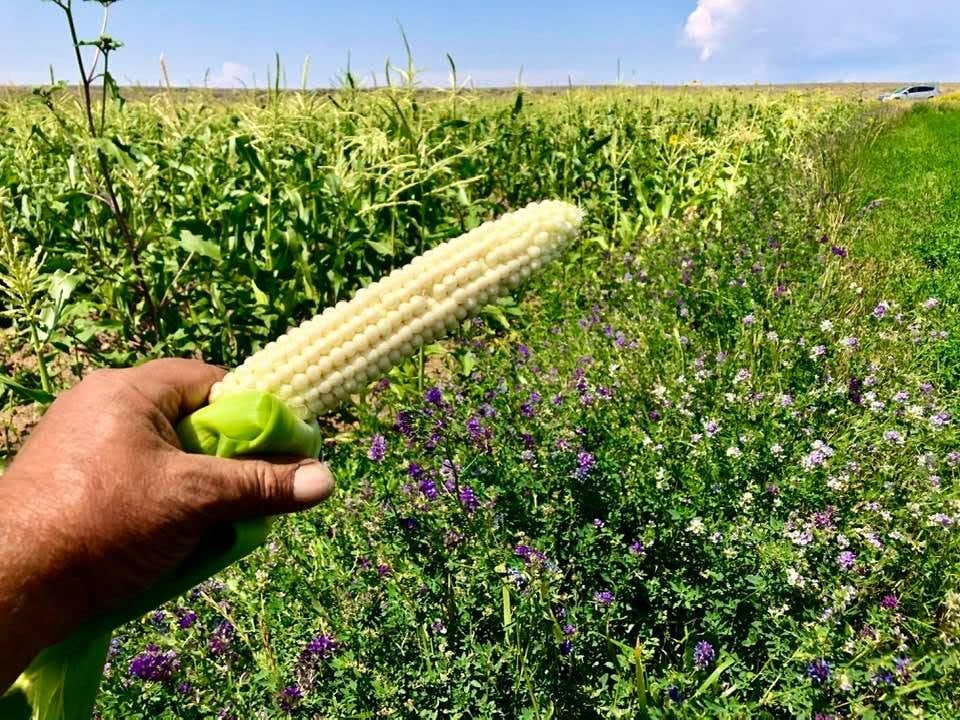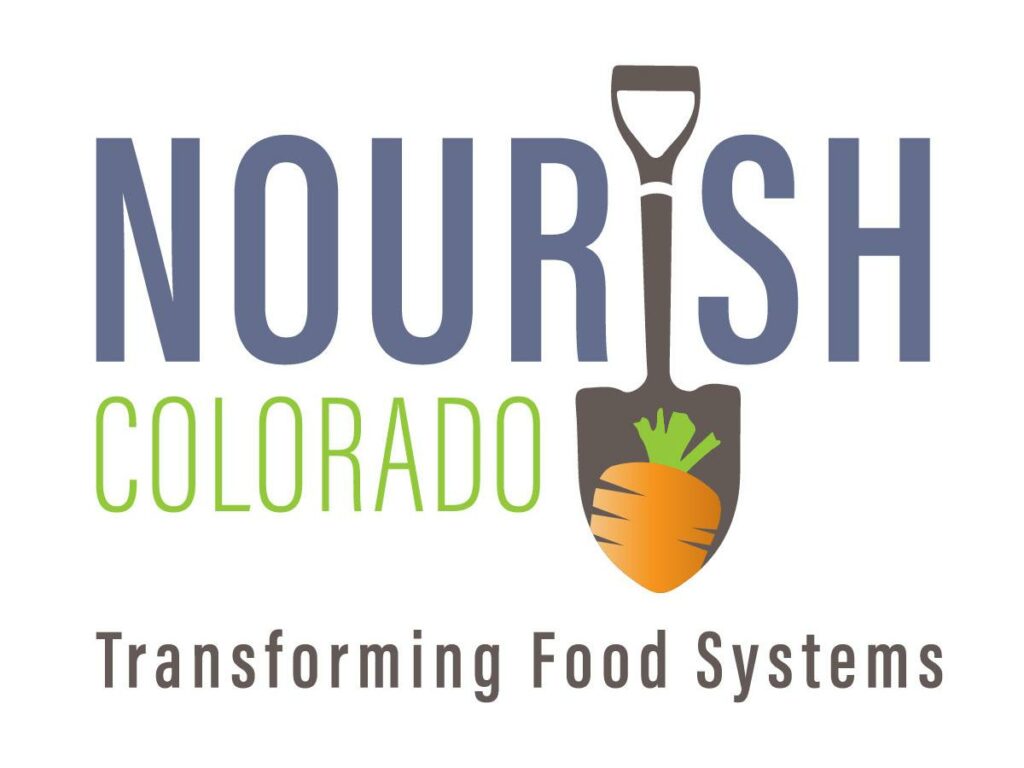By Sarah Thorson and Cole Dickerson, with research assistance by Olivia Brown
This disclaimer informs readers that the views, thoughts, and opinions expressed in this blog belong solely to the author, students of CU Boulder’s Masters of the Environment (MENV) program and their research, not necessarily to Nourish Colorado as an organization, nor does the blog represent the work that Nourish Colorado is leading.
Additionally, the authors would like to acknowledge that as a group of white graduate students who are not Indigeneous to the lands of Turtle Island, we write this from a position of allyship and academic study. We strive to explore what has come before us and inform ourselves of justice concerns related to the fields we study. We hope to share some of what we have learned with you.
Harvest season is upon us! Here in Colorado, we are enjoying more fresh fruits and veggies with warmer weather and water flowing. We may be visiting farmers markets and farm stands to find locally grown food to eat, supporting our farmers and their land management practices in the process. Colorado has a shorter growing season than many other states around the country, and certain foods accessible to other regions year round are available for shorter periods here. Many Coloradans spend the winter months looking forward to eating our local peaches when the weather is warm and take great pride in the fruit from the Western Slope.
While we may treasure a Palisade peach, have you ever wondered about the foods grown by the native peoples who originally called these lands home? The same history that removed Indigenous people from their ancestral lands across Turtle Island has disconnected folks from their foodways, leaving tribal communities with increased rates of chronic illnesses and other health issues.
As stated by the Blueprint for Community Ownership, Empowerment & Prosperity in the Chesapeake Foodshed: “Like any thriving ecosystem, our food system has lost vital diversity in farm ownership and production, cultivation techniques, and sustainable Indigenous philosophies, leaving us less resilient on one hand and increasing racial inequities on the other.” Environmentally sustainable agriculture needs to be rooted in Indigenous knowledge of the land and ecology.
History of Disconnection and Separation
While U.S. history is riddled with injustices enacted upon Native people, the Homestead Act of 1862 is particularly pertinent to this discussion. This act allowed for land claims in thirty states, however, the areas being claimed by homesteaders (usually white settlers) were often already inhabited or stewarded by native peoples and had not been officially ceded to new ownership. What’s more, Native Americans did not believe in ownership of land in the way homesteaders conceived it. As more land was grabbed up by settlers, less was left in the care of Native tribes and governments. They watched the lands that had always been their home lose native plants and animals, saw ancient waterways redirected, fences built and soil disturbed.
Efforts Towards Native Food Sovereignty
Tribal communities around the country are working for justice and food sovereignty in traditional and innovative ways, and the COVID-19 pandemic is inspiring even more work in strengthening native food systems. Four characteristics common in such projects are a focus on traditional foods and culture, using combinations of programming for greater impact, the ability to provide healthier food to more people, and social, economic and environmental sustainability.
Here in Colorado, a group working to empower native communities through a myriad of programs is Denver-based nonprofit Spirit of the Sun. Their mission “is to work in partnership with Native American communities in urban areas and on reservations to boost the resilience of Native people, especially youth and young adults.” The organization has been working toward their vision since 2002, led by Indigenous womxn.
The Blueprint for Community Ownership, Empowerment & Prosperity in the Chesapeake Foodshed, while focusing on the region in the Northeast, puts forth six general recommendations that can be applied in other regions looking to do similar work:
- Fight monopolies and address inequity in the food system
- Give land back! Land reparations to Indigenous and Black communities
- Secure dignity and fairness for food chain workers and their families
- Center resiliency in the face of climate change
- Agroecology provides pathways for interdependent livelihoods, healing, and liberation for people and land
- Honor that frontline communities know what they need for liberation
Check out the full report for more details about these recommendations!
On the national scale, the Native American Food Sovereignty Alliance supports Indigenous communities with advocacy, education, and networking in revitalizing their food systems. Their current programming includes a Native Food & Culinary Program, which helps reconnect folks to their traditional diets for improved health and wellness, and the Indigenous SeedKeepers Network, which brings together Indigenous seedkeepers across Turtle Island in cultivating traditional seeds and returning crops to their native lands – they have even created an assessment toolkit to assist Native communities in reclaiming their local and traditional seed systems.
In the wake of COVID-19, the Native American Agriculture Fund released an economic report making the case for infrastructure investments to develop regional Native food systems. The report argues that Native American food and agriculture is an untapped resource for sustainable rural and regional development that could benefit Tribal communities as well as their non-Tribal neighbors in rural areas around the country. They conclude that a $3.4 billion investment in the proposed infrastructure will return $9+ billion in value, supporting Tribal economies, improving rural economies, providing opportunity for Native farmers and ranchers, and creating a sustainable, resilient food system.
Spotlight on Colorado Maiz de Concho
Most people are aware that corn (also known as maize or maiz) has historically been a staple crop of Native American communities. Farmers in Colorado’s San Luis Valley contribute to heirloom maize diversity and work to sustain several methods and practices in the cultivation and use of native crops, such as the local white flint maiz de concho. Research on this local corn variety has suggested genetic purity, meaning it hasn’t been crossed with hybrid or genetically engineered varieties grown by many conventional corn farmers around the U.S. The research also shows a few adaptations of this variety that has helped it evolve to survive in the high-altitude cold deserts of the region, which are characterized by short growing seasons and frosts in late spring and early fall.

Maiz de concho from The Acequia Institute’s farm, Almunyah de la dos Acequias. Photo Credit: Dr. Devon G. Peña. https://www.facebook.com/TheAcequiaInstitute/photos/1383425291866961
Given the importance and rarity of these varieties of maiz, the seeds are collected and saved! The Almunyha Seed Library, a living seed library managed by The Acequia Institute, ensures that maiz de concho, among heirloom varieties of beans and pumpkin/squash making up the Three Sisters, is protected from threats to its unique genetics. These seeds play a large role in the effort to re-Indigenize the Chicana/o/x communities surrounding San Luis—descendants of the Aztec and other Indigenous communities from the land now known as Mexico and the Southwestern United States.
Try Native food and support Indigenous producers!
If you live in the Denver area (or are planning to visit), check out Tocabe, an American Indian eatery, and the Tocabe Indigenous Marketplace! The restaurant focuses on Native foods and the menu features recipes that have been passed down through generations. They have locations in north and south Denver as well as a food truck and catering services.
The marketplace is also located in Denver and offers online ordering options as well. They supply goods such as wild rice, different varieties of corn products, bison meat, traditional spice rubs, and more! Tocabe is leveraging relationships with suppliers to build an economy that benefits Native communities and helps retain resources. For every two items sold, they donate one item to a Native community organization.
Boulder Chips is another Colorado company that uses Native American corn in its products. The corn is sourced exclusively from the Ute Mountain Ute Tribe, and the traditional preparation method of nixtamalization is used in processing the product. Buy their tortillas, chips, and dips online or at a store near you! And if you want some cornmeal to cook with at home, check out Bow & Arrow – they also have recipes on the website! The brand is part of the Ute Mountain Ute Farm & Ranch Enterprise, and more products and information can be found there.
If you’re looking to learn more about Native foodways…
- Watch: Gather
- Read: The Color of Food by Natasha Bowens
- Listen: INDIGENIZE!
Take it a step further and educate yourself and your friends about federal-tribal policy as it relates to food. There will be a new Farm Bill in 2023, and we can all advocate for policies that support Native communities and food producers. To get started, check out a report outlining implications for tribal nations of the 2018 Farm Bill.
